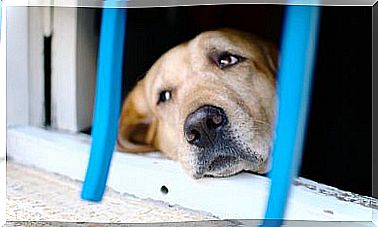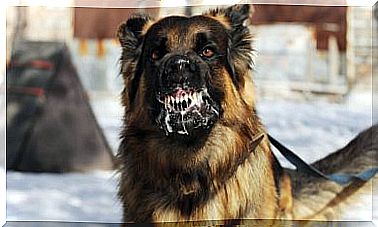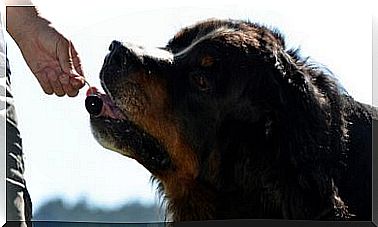6 Consequences Of Tartar In Dogs

The dental health of domestic dogs is something that some guardians tend to pay little attention to. Many believe that these animals, because of their “wild” condition, do not require extensive dental care and cleaning. Nothing is further from reality, as the consequences of tartar in dogs can be serious.
As excessive as it may seem, multiple veterinary portals recommend brushing dogs’ teeth daily. It has been scientifically proven that this greatly reduces the chances of the appearance of bacterial diseases and gum inflammation (gingivitis), among many other pathologies.
What is tartar?
As indicated by specialized portals in dental health, tartar is defined as dental plaque that has hardened due to the precipitation of minerals in saliva and gum fluid. Oral tartar is composed of organic and inorganic matter, but the latter is predominant – up to 60% of the total.
This material provides dental plaque formed by bacteria with a larger surface to grow on, which can lead to a series of mild and serious diseases in both dogs and humans. Thus, tartar is not only an aesthetic issue, it can compromise the health of those who present it.

What are the consequences of tartar in dogs?
The formation of tartar not only compromises the canine’s oral hygiene, as it can lead to certain systemic diseases in the most serious cases. Next, we show you the 6 consequences of tartar in dogs.
1. Halitosis
Bad breath in dogs is very common, especially in older dogs senior . That the mouth odor of a dog is strange to us is totally normal, since these animals are in close contact with feces, decomposing matter and other organic elements that, for humans, are at least unpleasant.
Even so, when the breath reminds of rotten food or the stench of a garbage can, surely something is wrong with the dog’s oral health, especially if it is young. Many times these strong odors come from bacterial colonies that have settled in the dog’s mouth and are rotting his bones and oral mucous tissues.
2. Gingivitis
Gingivitis is defined as inflammation of the oral, lingual or oropharyngeal mucosa of the dog. This causes the animal to develop mouth ulcers, excessive salivation and even difficulty eating.
When a dog has tartar, bacteria that can be pathogenic accumulate on the gums. They release toxins, causing damage to surrounding tissues. The animal’s immune system reacts to these lesions and sends white blood cells to the site of infection, a process by which the characteristic inflammation of the gums is generated.
3. Periodontitis
If gingivitis is not treated promptly, periodontitis appears. In this case, the inflammation of the gums is much more serious, as it is accompanied by a degeneration of the bones and supporting structures around the dog’s teeth. This process can be controlled but not completely repaired, since the bone damage has already been done.
It is the most common cause of dental disease in dogs, since veterinary portals estimate that 80% of domestic dogs present this pathology or other similar ones from 2 years of age. Halitosis or bad breath is the first detectable clinical sign of periodontitis, but it can lead to much worse conditions if left untreated.
4. Loss of teeth
This process is completely linked to periodontitis, since pathogenic oral bacteria cause the degeneration of the teeth and their supports. Dental fractures can be complicated or uncomplicated, depending on whether nerves and blood capillaries are exposed after the injury.
The most common symptoms after the loss or breakage of a tooth in the canine are pain, discomfort and bleeding near the compromised structure. If this injury is not treated, it can lead to a systemic infection.
5. Endocarditis
Endocarditis is an infection of the endocardium, the tissue that lines the inner parts of the heart’s valves and chambers. Oddly enough, bacteria that proliferate uncontrollably in the dog’s mouth can enter the bloodstream (bacteremia) and, from there, migrate and settle in heart tissue.
This results in symptoms such as lethargy, anorexia, weight loss and weakness in the animal. Shortness of breath, increased blood pressure, and intermittent fever may also be seen. If not treated with antibiotics, a dog with endocarditis can die.
6. Kidney and liver failure
Bacteria that enter the blood after periodontitis can also migrate to the liver and kidneys. This translates into kidney and liver failures that lead to extensive symptoms, depending on the site of infection and its severity.

As you can see, the consequences of tartar in dogs go far beyond bad breath. Bacterial colonies that settle due to poor oral hygiene can cause tooth decay, gingivitis, and even serious systemic diseases.
Therefore, the ideal is to brush the dog’s teeth every day, without excuses. If this cannot be done for any reason, there are products that promote the oral hygiene of the dog without having to brush it as such.








